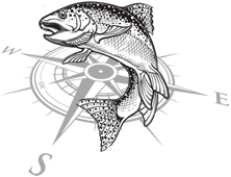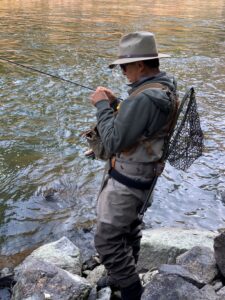 Fly Fishing the North Fork Payettte
Fly Fishing the North Fork Payettte
It never ceases to amaze me the lack of fly fishing pressure on the North Fork of the Payette River. Granted there may be good reasons why. Too much water, too rugged, too much nymphing or whatever. Have we gotten that lazy? I have heard it said that fly fishermen are the laziest humans on earth. I don’t buy into that, but a case can be made for that being the reason why fly anglers don’t fish the NF Payette. Now if a rugged river that’s artificially high and hard to fish are the reasons why anglers don’t fish that river I get it, I’m one of those guys. However there is a special time of the year when all those issues melt away.
There is a magic period of about 3 to 4 weeks a year when the river is perfect. Yes I said perfect. The wizard behind the curtain at Cascade reservoir decides to turn the river off making the river flows near perfect for fly fishing. For nearly 11 months of the year the NF Payette is yes, almost unfishable because of the high water and rough conditions. But during these few magic weeks the river flow is very manageable and there are kayak trails down to the river at nearly every turnout making a rough condition very manageable.
The trout on the NF Payette are almost all rainbows and are unfished for 11 months of the year. Outside of a floating kayak or a rare raft the river is pretty much devoid of fisherman. These poor trout are free to grow and can get quite large. The average trout in the NF Payette is around 10 inches with 16 inch trouts not uncommon. The section I’m writing about and the section of river I have fished the most over the last 3 decades is the stretch upriver from the railroad crossing and bridge just 3 miles north of Banks where the river begins its final stretch on the right side of the road to Big Eddy Campground. What I like about this stretch of river is that there is no one favorite spot. There are trout in concentrations throughout this section.
To fish this river successfully you have to keep your eye on the rivers flows or cfs of the NF Payette at Banks. You can get this information from USGS River Flow Idaho if you google it. Normally when the river flows are shut off at the dam it’s a gradual draw down to about 300 cfs or less. That’s the time to be planning on fly fishing this section of river. Of all the years I’ve been fishing the NF Payette I’ve always nymph fished the river. This is a tailwater river and the conditions for nymphing are exceptionally good. I can count on one hand how many times I’ve dry fly fished this river. Any style of nymphing will work but this river in particular lends itself to more of a Euro style or Drop Shot style of nymphing. I have used a 9 ft. 6wt fly rod for most of my nymphing there but as recently as about 4 years ago I’ve switched to a 10 ft 6wt rod.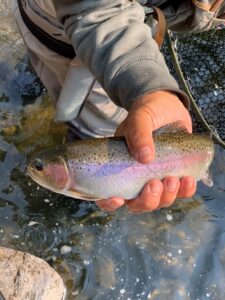
On most mornings, the first thing I do when I open the shop is sit down with my coffee and quickly go over the river flows in our area. Around September I start keeping my eye on the NF Payette waiting for the river to drop. This past weekend it happened. The flows on the NF Payette dropped to 350 cfs and that’s a good level to give it a go. When the river drops to a manageable level you have to go fish it, like right now. The window for fly fishing the NF Payette is between when the river drops and the time change to daylight savings time, this year November 1st. If you go before there is too much water, it you wait until after the time change then the sun never hits the river and that canyon turns into a freezer making fishing tough. It’s that magic time in between that fly fishing can be really good.
On the drive up to the river I stopped to pick up my friend Larry who lives close to the Payette and together we headed north to Big Eddy Campground. As we drove along the river we both noticed a few folks that were fishing the river but none were fly fishermen. I have fished this river long enough to know the best time to be on this river is when the sun hits the river. When we arrived at Big Eddy Campground, I was surprised to see that the Forest Service had not closed the campground and there were a couple of folks camped there. This was on a Sunday and with a friendly hello they told us the fishing was lousy and they had not caught a fish all weekend. Nothing like starting out your day of fly fishing being told the fishing sucks.
One of the tricks to fly fishing both the North Fork and the South Fork of the Payette Rivers is to begin your fly fishing when the sun hits the water. I don’t know of any scientific facts that will back up that statement but in my 3 decades of fly fishing these rivers it doesn’t matter, the fishing is always better when the sun hits the water. In our case, we fly fished the upper part of the river just inside the campground and the sun was a foot or so from hitting the water. I began nymphing at the top of the run and after about 10 cast with no fish I noticed the sun was beginning to move across the river. After waiting a few minutes, I now had sun on the water and my first cast brought in a nice 12 inch rainbow.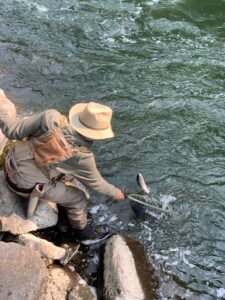
I spent the next 30 minutes or so bringing to hand another half dozen or so cookie cutter trout of the same size. I was drop shot nymphing using three flies that I had left over and already on my rod when I began fishing. The interesting thing is I had on a no name purple nymph that the trout were particularly fond of. All the trout I caught there hit the purple nymph. As an experiment I tied on, in addition to, two new nymphs: one bright red and one florescent green. The change in color had no effect on the trout, they still preferred eating the purple nymph.
Thank the Lord that there are still things in fly fishing that remain a mystery. I can think of quite a few things science wise that might make me understand the trout’s preference to the color purple. I can tell you similar stories of me catching trout using a purple nymph, midge or dry fly but then again, I can tell you just as many stories of catching trout on other colors while the trout ignore any fly with the color purple. The bottom line is on this particular day’s fishing, by happenstance, I already had a purple fly on my drop shot rig and just left it on. The results were I caught quite a few trout on the North Fork Payette River. There is some luck to this story, I was lucky that I already had a purple nymph on my drop shot rig. I was lucky that the trout there wanted to eat it. And I was lucky that I didn’t lose that purple nymph because I didn’t have any other purple nymphs in my fly box.
I have had a few decades fly fishing this river and have learned a few tricks that may help you along the way. When the river is running low, (which is when you should be fly fishing it) you are able to see a river that does not exist for much of the fishing season. There is an abondance of exposed boulders creating what looks like the best pocket water of any river in the west. We all love pocket water, it’s where trout live. That may be true for the NF Payette River too but looks can be deceiving. Strategy dictates that we should be fishing this type of water but experience tells me this strategy is wrong and instead you should concentrate on fly fishing the long tailout portions of the river instead. Yes you can catch trout in the NF Payette’s pocket water but the results will be a lot of slipping, sliding and rock hopping and the end results will be fatigue of your legs and a bruise on your knee.
That’s a lot of work for some small trout. The better strategy, or shall I call it an exception, is to instead focus on the long tailout portions of the river. This is where the big trout live. On days where the sun is out and the weather is normal you can catch multiple large trout out of every long tailout you find. Economy of Time dictates that you spend all your time fly fishing the most productive sections of the river whenever possible. Just work a particular tailout until you are satisfied you have fished it thoroughly then walk back to your vehicle and drive to the next tailout.
I’m a Drop Shot nymph fisherman and my fly fishing partner on this day is a Euro style “Frenchie” style nymph fisherman. Recently I was with him on the NF Payette River working these tailout sections I’m writing about. We fished 3 total tailouts and we each caught over 10 trout per tailout and the average size trout was in the 13 to 16 inch range. We caught several trout in the 18 to 20 inch range. Neither of us caught our fish on the same fly. All our trout where caught on various styles of flies. This particular day it didn’t matter what fly we used we caught fish.
The point is it’s not so important what fly you use, what is important is for you to make sure the nymphs that you do use are presented right in front of the trout. The mistake some of NF Payette anglers make is they have their nymphs everywhere except in front of the trout. It pays to have too much lead than to not have enough. With too much lead I might get caught on the bottom and loose my flies but at least I will catch fish. If I don’t have enough lead or weight then I run the risk of not catching any fish at all.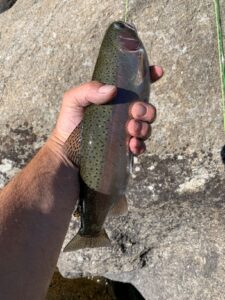
Be prepared to lose flies and leaders. The river bottom on the NF Payette river is extremely rocky. I don’t care what style of nymphing you choose to do you will lose flies and leaders. It’s an occupational hazard that the NF Payette is known for. For safety reasons I recommend that you don’t wear waders. You can comfortably cast your nymphs from shore or stand on a boulder and make effective casts. I wear on my feet some expensive high tech hiking shoes with a black sticky rubber sole and a nylon upper so I can get my feet wet and have them dry quickly as well as stick to rocks like a gecko.
My son and I just arrived home after a 600 mile three day journey to fly fish as many rivers Northeast of Boise as we could. We fished a ton of water and saw some great country. On the way home traveling along Hwy 21 I said to Brian to turn right on Hwy 55 and let’s fish the NF Payette for a short while before returning home. I fished the NF Payette River for about an hour and caught more trout and bigger trout than I did on any river that we had previously fished the three days before. It’s this old fish hobo’s opinion that for about a 4 to 6 week period each year there is no finer or better fly fishing river in the Northwest than the North Fork Payette River.
Mike Sandifer
